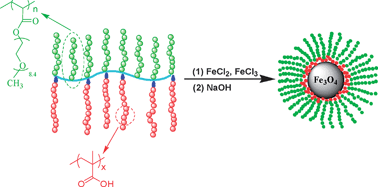Synthesis of PPEGMEA-g-PMAA densely grafted double hydrophilic copolymer and its use as a template for the preparation of size-controlled superparamagnetic Fe3O4/polymer nano-composites†
Abstract
A series of well-defined amphiphilic densely grafted

* Corresponding authors
a
Laboratory of Polymer Materials and Key Laboratory of Organofluorine Chemistry, Shanghai Institute of Organic Chemistry, Chinese Academy of Sciences, 354 Fenglin Road, Shanghai 200032, P. R. China
E-mail:
xyhuang@mail.sioc.ac.cn
Fax: +86-21-64166128
Tel: +86-21-54925310
b The Key Laboratory of Molecular Engineering of Polymer, State Education Ministry of China, Department of Macromolecular Science, Fudan University, 220 Handan Road, Shanghai 200433, P. R. China
A series of well-defined amphiphilic densely grafted

 Please wait while we load your content...
Something went wrong. Try again?
Please wait while we load your content...
Something went wrong. Try again?
L. Gu, Z. Shen, C. Feng, Y. Li, G. Lu, X. Huang, G. Wang and J. Huang, J. Mater. Chem., 2008, 18, 4332 DOI: 10.1039/B805841E
To request permission to reproduce material from this article, please go to the Copyright Clearance Center request page.
If you are an author contributing to an RSC publication, you do not need to request permission provided correct acknowledgement is given.
If you are the author of this article, you do not need to request permission to reproduce figures and diagrams provided correct acknowledgement is given. If you want to reproduce the whole article in a third-party publication (excluding your thesis/dissertation for which permission is not required) please go to the Copyright Clearance Center request page.
Read more about how to correctly acknowledge RSC content.
 Fetching data from CrossRef.
Fetching data from CrossRef.
This may take some time to load.
Loading related content
